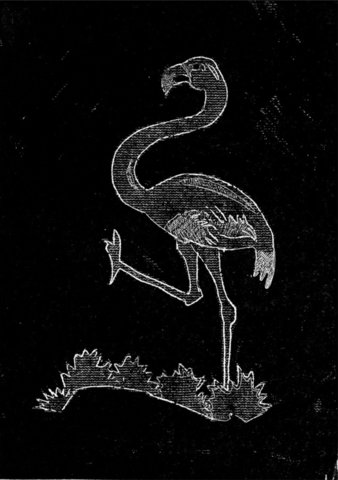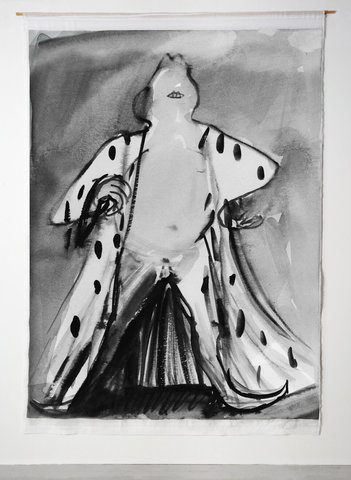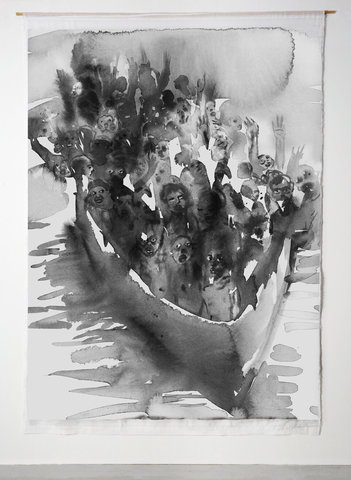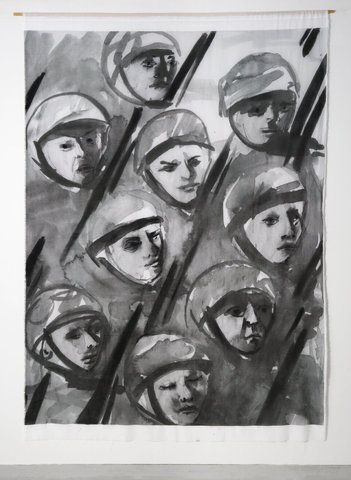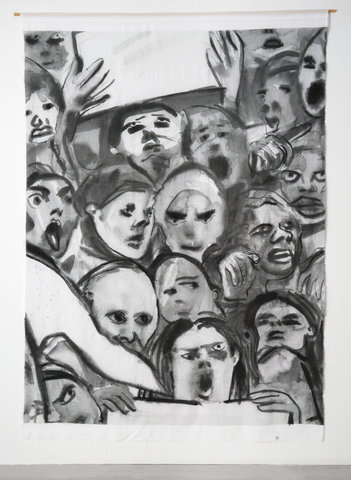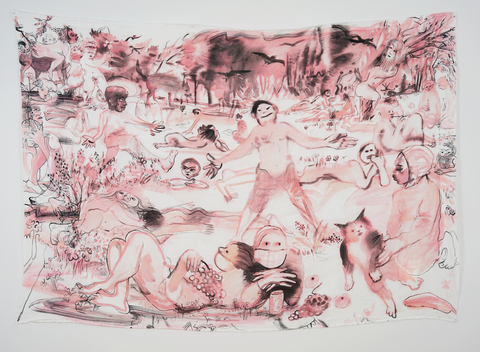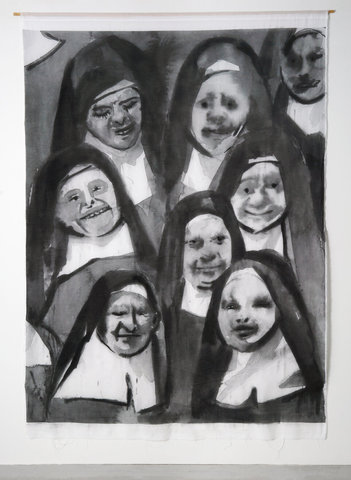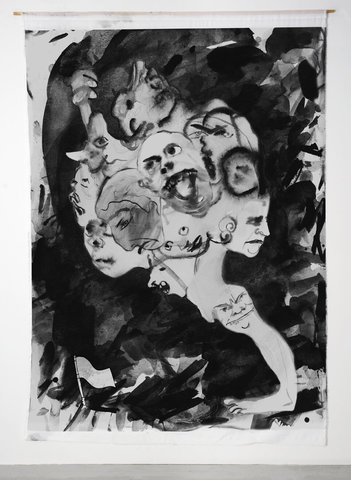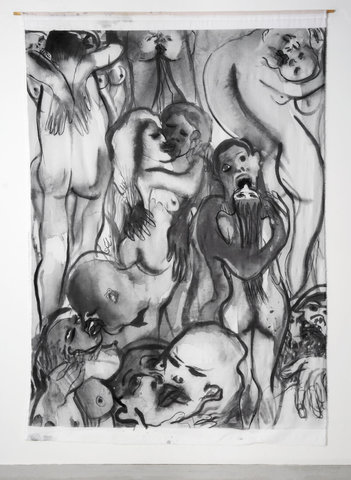Alina Bliumis
Alina Bliumis is New York-based artist. Alina received her BFA from the School of Visual Art in 1999 and a diploma from the Advanced Course in Visual Arts in Fondazione Antonio Ratti, Como, Italy in 2005. Alina often collaborates with Jeff Bliumis, their collaboration started in 2000.
Alina has exhibited internationally at the Musée national de l’histoire de l’immigration, Paris, France, the First Moscow Biennales of Contemporary Art (Moscow, Russia), Busan Biennale (Busan, South Korea), Assab One (Milan, Italy), the Bronx Museum of the Arts (New York, US), Galerie Anne de Villepoix (Paris, France), Centre d’art Contemporain (Meymac, France), the James Gallery, The Graduate Center CUNY (New York, US), Museum of Contemporary Art (Cleveland, US), Museums of Bat Yam (Bat-Yam, Israel), the Jewish Museum (New York, US), the Saatchi Gallery (London, UK), Botanique Museum (Brussels, Belgium), the Victoria and Albert Museum (London, UK), MAC VAL - Musée d’art contemporain du Val-de-Marne (France).
Her works are in various private and public collections, including MAC VAL - Musée d’art contemporain du Val-de-Marne, France; Musée national de l’histoire de l’immigration, Paris, France; The Victoria and Albert Museum, London, UK; Moscow Museum of Modern Art, Russia; Bat Yam Museum for Contemporary Art, Israel; The Saatchi Collection, UK; The Harvard Business School, USA; The National Museum of American Jewish History, Philadelphia, USA and Missoni Collection, Italy.
SOLO PROJECTS AND EXHIBITIONS
- 2020 — A Painting For A Family Dinner, with Jeff Bliumis, Tokyo Biennale, Japan
- 2020 — (Upcoming) Narrating Against the Grain, Kunstihoone, Tallinn, Estonia; with Tanja Muravskaja, curator Corina L. Apostol
- 2020 — (Upcoming) Drawing Now, Galerie Anne de Villepoix, Paris, France
- 2020 — (Upcoming) Masses, Spring/Break Art Show, New York, USA; curator Elizabeth M Grady
- 2019 — Classification Patterns: Christian, Muhammad, Lee, “Y” Gallery of Contemporary Art, Minsk, Belarus; curator Irena Popiashvili
- 2019 — On the Land of Eagles, Galerie Anne de Villepoix, Paris, France
- 2019 — Poems without Borders, Project Statement, Parallel, Vienna, Austria Nations Unleashed, Spring/Break Art Show, New York, USA; curator Ksenia Nouril
- 2018 — Political Animals, Aperto Raum, Berlin, Germany
- 2018 — Political Animals, Aperto Room, St.Petersburg, Russia
- 2018 — Amateur Bird Watching at Passport Control, Pushkin House, London, UK; curator Elena Zaytseva
- 2018 — Cultural Tips For New Americans Under Trump, Spring/Break Art Show, New York, USA; curator Ksenia M. Soboleva
- 2016 — Cultural Tips For New Americans, Popiashvili Gvaberidze Window Project, Tbilisi, Georgia
- 2016 — Recent Works, Bushel, Delhi, NY, US
- 2014 — Thank You Paintings Exchange, Denny Gallery, New York, USA
- 2014 — Casual Conversations, The Laurie M. Tisch Gallery, New York, USA
- 2013 — Which country is the best to move to? Galerie Anne de Villepoix, Paris, France
- 2013 — A Painting For A Family Dinner / Lecce, Italy, Ammirato Culture House (ACH), Lecce, Italy
- 2013 — A Painting For A Family Dinner / Beijing, China, Inside-Out Art Museum Artist-in - Residency, Beijing, China
- 2012 — Cultural Tips Takeaway, Toomer Labzda Gallery, New York, New York
- 2012 — Language Barrier and Other Obstacles, Peacock Visual Arts, Center For Contemporary Art, Aberdeen, UK
- 2012 — A Painting For A Family Dinner / Bronx, NoLongerEmpty, documentation at the Bronx Museum of the Arts, USA
- 2012 — Casual Conversations, National Museum of American Jewish History, Philadelphia, USA
- 2011 — Cultural Tips For New Americans, NoLongerEmpty, Ideas City Festival - New Museum, New York, USA
- 2011 — Global Reach Inc. Andrea Meislin Gallery, New York, USA
- 2010 — Cultural Tips For New Americans, Stanislas Bourgain Galerie, Paris, France
- 2009 — Casual Conversations in Brooklyn, Black and White Project Space, Brooklyn, New York, USA
- 2008 — A Painting For A Family Dinner / Bat Yam, Israel, Bat Yam Museum for Contemporary Art, Israel.
- 2008 — Dam Lines, Andrea Meislin Gallery, New York, USA (catalog)
- 2008 — Language Barrier / Lower Manhattan, public art project, Lower Manhattan Cultural Council, New York, USA
- 2008 — Language Barrier–Yellow Pages, Stanislas Bourgain Galerie, Paris, France
- 2008 — Hello, USA? Contemporary City Foundation, Moscow, Russia (catalog); curator Andrei Parshikov
- 2008 — Language Barrier, Pulse, New York, USA
- 2005 — Cloning Factory, MuseumsQuartier, Vienna, Austria
GROUP EXHIBITIONS
- 2019 — Persona Grata, MAC VAL, Musée d’art contemporain du Val-de-Marne, France; curator Anne-Laure Flacelière and Isabelle Renard Cosmopolitics, Comradeship, and the Commons, Suoja/Shelter festival, Helsinki, Finland, curators Corina L. Apostol, Ksenia Yurkova and Anastasia Vepreva.
- 2018 — Persona Grata, Musée national de l’histoire de l’immigration, Paris, France, curator Anne-Laure Flacelière and Isabelle Renard
- 2018 — Project Statement, Parallel Vienna; curator Maria Kalinina
- 2018 — PRO____BEL, Belarussian Art Abroad, Villa Sokrates Foundation, Krynki, Poland; curator Andrei Dureika
- 2018 — Babble, Gallery CA Baltimore, MD, US; curator Yuzhuo Mark Zhang
- 2017 — Ernst, Boris Yeltsin Presidential Center, Yekaterinburg, Russia
- 2017 — Amateur Bird Watching At Passport Control, Popiashvili Gvaberidze Window Project, Viennacontemporary, Vienna, Austria
- 2016 — Now to remember the future is not possible?, Fest I Nova, Garikula, Georgia, curator Nutsa Chikvaidze
- 2016 — The Lives of Forms, Lower East Side Printshop, New York, USA; curator Ksenia Nouril
- 2016 — Making Continuity Contemporary: Eastern Europe in New York, Derfner Judaica Museum, Bronx, NY
- 2016 — The Bronx Speaks Our Home, Andrew Freedman Home, Bronx, NY; curator Sarah Corona
- 2015 — DEAD: A Celebration Of Mortality, Saatchi Gallery, London, UK
- 2015 — Specters of Communism: Contemporary Russian Art, James Gallery, CUNY Graduate Center, NY, USA; curator Boris Groys
- 2014 — NASS BELGICA L’immigration marocaine en Belgique, Botanique Museum, Brussels, Belgium
- 2014 — Time::Code, Whitebox Art Center, New York, USA
- 2013 — Unhinged, Pierogi Gallery, Brooklyn, NY, USA
- 2012 — This Side of Paradise, NoLongerEmpty, Andrew Freedman Home, Bronx, New York, USA
- 2012 — Foreign Bodies, Barbur, Jerusalem, Israel; curator Yevgeniya Baras
- 2012 — Generation One and a Half, Abrazo Interno Gallery, New York, USA; curator Yulia Tikhonova
- 2012 — Civil Disobedience Festival, De Balie Centre for Culture and Politics, Amsterdam, the Netherlands; curator Tania Volkova
- 2012 м Foreign Bodies, Set Gallery, Brooklyn, New York, USA; curator Yevgeniya Baras
- 2011 — Media Impact. International Festival Of Activist Art, the Fourth Moscow Biennale, Russia (catalog); curator Tania Volkova
- 2011 — About Face, NoLongerEmpty, Festival of Ideas for a New City, New Museum New York, USA
- 2011 — Electrica, Instituto Cervantes, New York, USA
- 2010 — New Acquisition, The Victoria and Albert Museum, London, UK
- 2010 — Artistes russes: Un art au superlatif, Centre d’Art Contemporain, Meymac, France
- 2010 — Now We Are Six, Andrea Meislin Gallery, New York, USA
- 2009 — American Dream / Be Happy, Pulse Miami Installation Program, USA
- 2009 — Frozen Reality, Holster Projects, London, UK
- 2009 — No Longer Empty, Chelsea Hotel, New York, USA
- 2009 — The Situation, Third Moscow Biennale of Contemporary Art, Moscow, Russia (catalog); curator Elizabeth M. Grady
- 2009 — Ultra-New Materiality, Third Moscow Biennale of Contemporary Art, Moscow, Russia (catalog); curator Andrey Parshikov
- 2008 — Moby Hosting, Bat-Yam Museum, Bat-Yam, Israel (catalog); curators Milana Gitzin-Adiram and Leah Abir
- 2008 — Off The Wall: Artists At Work, Jewish Museum, New York, USA; curator Andrew Ingall
- 2008 — Moscow - New York = Parallel Play, Chelsea Art Museum, New York, USA
- 2008 — A Matter of Time, Andrea Meislin Gallery, New York, USA
- 2007 — MOCA Mix film, Museum of Contemporary Art, Cleveland, USA
- 2007 — Left Pop, Second Moscow Biennale of Contemporary Art, Russia (catalog); curators Diana Baldon, Georgina Jackson, Nicola Lees
- 2007 — Media Image and Unconscious, the Second Moscow Biennale of Contemporary Art, Moscow, Russia
- 2007 — Victory Over The Sun, National Center of Contemporary Arts, Moscow, Russia (catalog); curator Vitaly Patsukov
- 2006 — Making Love to My Ego, Castlefield Gallery, Manchester, England
- 2006 — Refuge, Busan Biennale, Busan, South Korea (catalog); curator Yun Cheagab
- 2006 — Out Of Paint, Kuhn Gallery, Ohio State University, Marion, USA
- 2006 — Unauthorized Access, Hermitage Museum, St. Petersburg, Russia
- 2006 — Aesthetics of Resistance, Assab One, Milan, Italy (catalog); curator Roberto Pinto
- 2006 — Contested Spaces in Post-Soviet Art, Sidney Mishkin Gallery, New York, USA; curator Elena Sorokina
- 2006 — Korperchen, Veranstalter Medienwerkstatt, Vienna, Austria
- 2005 — Russia Redux #1, Schroeder Romero Gallery, New York, USA;; curator Elena Sorokina
- 2005 — Aesthetics of Resistance, Fondazione Antonio Ratti, Como, Italy (catalog); curator Roberto Pinto
- 2005 — Post-Diasporas: Voyages and Missions, the First Moscow Biennale of Contemporary Art, Russia (catalog); curator Olga Kopenkina
- 2004 — Symbols of The Big Bang, Santa Fe Art Institute, Santa Fe, USA
RESIDENCIES:
- 2013 — Ammirato Culture House, Lecce, Italy
- 2013 — Inside-Out Art Museum (IOAM), Beijing, China
- 2009 — Black and White Project Space, Brooklyn, New York, US
- 2005 — Quartier 21, MuseumsQuartier, Vienna, Austria
GRANTS AND FELLOWSHIPS:
- 2016 — Foundation for Contemporary Arts Emergency Grant, New York, US
- 2014 — Genesis Grant, Genesis Philanthropy Group, New York, US
- 2011 — Foundation for Contemporary Arts Emergency Grant, New York, US
- 2011 — Blue Print Fellowship, New York, US
- 2010-2011 — Franklin Furnace Fund, New York, US
- 2009 — Trust for Mutual Understanding, New York, US
- 2008 — Art in Public Spaces Grant, Lower Manhattan Cultural Council, New York, US
- 2008 — Strategic Opportunity Stipend, New York Foundation for the Arts, New York, US
- 2008 — Puffin Foundation Grant, Teaneck, US
- 2007-2009 — Six Points Fellowship, New York, US
- 2005 — Trust for Mutual Understanding, New York, US
PUBLIC COLLECTIONS:
- MAC VAL - Musée d’art contemporain du Val-de-Marne, France
- Musée national de l’histoire de l’immigration, Paris, France
- The Victoria and Albert Museum, London, UK
- Moscow Museum of Modern Art, Russia
- Bat Yam Museum for Contemporary Art, Israel
- The Saatchi Collection, UK
- The Harvard Business School, USA
- Missoni Collection, Italy
SERIES "MASSES"
The series Masses (2019-2020), by Alina Bliumis is an exploration into the tipping point, where analysis becomes obsession and participation becomes dissolution, as the individual relinquishes a sense of self in the face of phenomenological overwhelm. At 58 x 83” the cotton panels that comprise the series depict crowds of over-life-size figures representing internal and external encroachment on the psyche. To pass between and among the monochrome gossamer hangings, which combine digital print and watercolor, is to revisit each time you’ve experienced that transcendent moment of fear or ecstasy where the only certainty is that you’ve given up your personal agency to the mob.
Masses #1 is perhaps the most anomalous of the series, focusing as it does on an internal struggle. Evoking the howling forces of worry and self-doubt that visit in the blackness of the small hours of the morning, the work suggests a descent into a demon-plagued hell of our own devise. Monstrously twisted and disembodied limbs vie with attenuated spectral faces for command of the poor soul, bent over at the base of the composition, and gazing apprehensively over its shoulder at the reigning chaos. As riveting as it is disturbing, it is Fuseli’s Nightmare for our troubled times.
On a lighter note, Bliumis turns to mass celebrations of Dionysian excess in the rock concert depicted in Masses #2. The main figure is blissed-out and spread-eagled in mid-stage-dive. The darker side of the experience is intimated by the blackened eye sockets and inverted pose of the figure, however, and we are left to question whether the stage-diver’s act is a celebration of music and communal experience or a kind of temporary martyrdom, where consciousness is sacrificed through the use of drugs for release from the pressures of this mortal coil. The veiled reference to St. Peter, who as legend has it asked to be crucified head-down so as not to risk dilution of the memory of Christ’s torture, cannot be lost on anyone familiar with the Western tradition.
Front-page news often records crowd hysteria, and the palette of Bliumis’ series reinforces the newspaper reference in works like #7-8 and #5 which depict a Protest and Soldiers respectively. In the former, there are as many emotions as faces, showing the rage, fervor, anxiety, devotion and hope that can forge a compelling collective identity at mass demonstrations. Yet one is left to wonder, given the multiplicity of expressions, if these protestors will every achieve a unity of communal purpose. The soldiers, in their uniformity, are a stark reminder that in rigid discipline and conformity comes another kind of excess that can be wielded as a blunt and unforgiving weapon against a mass of individuals.
Abandonment of reason is a theme that carries through several of these panels, not least in the Masses #3 (Lovers). Here, bodies entwine in the abandonment of an orgy, with the ebb and flow of momentary sensations evoked by shifts in scale, as in the couple at center right; or the union of body parts, like the heads at the bottom center, whose mouths unite when the tongue of the head on the right becomes the lips of the head on the left, in a perceptual twist that would have made Cezanne proud.
The installation of the works, as large fabric panels dividing the space, will create a disorienting experience for viewers, ideally a psychological state that hints at if not approximates the loss of self experienced when one becomes part of a crowd or mass, whether for good or for ill, ecstasy or violence. Bliumis depicts scenes where mass experience tips over into mass hysteria, where the intellect is overcome by emotional input. What differentiates a rally from a revolution? A riot from a rock concert? Whether attending a military exercise, a religious rite or an orgy, overload provides release through collective identification with a larger purpose.
Text by Elizabeth M. Grady
SERIES "AMATEUR ORNITOLOGY ON PASSPORT CONTROL"
The series “Amateur Birdwatching at Passport Control” is dedicated to birds depicted on the covers of passports from around the world.
From eagles to pigeons, from Albania to Tonga, this series explores the intersection of nation and nature. Birds are often part of the national hereditary symbol system or coat of arms and appear on passport covers with metallic gold. On 43 passport covers, I noticed 50 birds or related creatures.
In the works, I isolated each bird from its national symbolic context and painted it according to the source, focusing on the characteristics of the species: the famous one-legged pose of a flamingo (Bahamas), a gliding vulture (Mali), an extinct flightless dodo (Mauritius) and a mythological creature half woman and half bird, Harpy (Liechtenstein). Some birds were easy to identify, some required research using different birdwatching sources, discussion with friends and experts.
I created each bird on a copper plate, etched and printed in one copy, the result is “Amateur Birdwatching at Passport Control”, album, 2016-2017, series of 43 works, relief etching on paper, 12 x 9 inches.
Then I scanned the unique prints and printed them on fabric: Amateur Birdwatching at Passport Control, 2018, 43 series, digital print on silk paper, 44 x 54 inches each, Vol. 3.
Special edition for a—s—t—r—a gallery of 11 works, digital printing on paper, 30 x 40 cm each.
Alina Blumis
What do the birds dream about?
When we speak about globalization we mostly mean the global circulation of information, money and commodities. However, long before this circulation started animals, birds and insects were circulating around the world – and they still are. Migration of birds and animals preceded the migration of men. At the same time not all the animals migrate. Some of them are local – and parts of local ecologies. That is why migration of animals and other living organisms, such as viruses and microbes, is seen as dangerous for the ecological balance in certain regions. Now, the analogy with the human migration is obvious. Often enough it is also seen as a negative factor destroying the ecological balance of certain national states.
Alina Bliumis came to the USA from Belarus. One of the persistent topics of her art is a reflection on the processes of accommodation and integration in which everyone with a similar background is unavoidably involved. The tone of this reflection is far from being dictated by personal ressentiment or protest. Rather, her attention is drawn by the absurdities of the processes themselves. Her recent projects “Amateur Bird Watching at Passport Control” and “Political Animals” deal with the images of animals and birds that serve as symbols for different national states and thus put on the official documents, including passports, of their citizens. There is this standard expression: free as a bird. Speaking about the freedom of birds we mean, of course, the migrating birds that high in the sky cross all the national borders – the freedom which the planes, for example, do not have.
However, the birds which images we find in our passports are not migrating birds. Mostly, they are birds of prey – like eagles, for example. In this respect they are similar to the political animals – lions or bears. The eagles do not migrate – they are circling in the air and controlling their territory. They are machines of surveillance. They look for a prey – and catch it. So it is clear enough why so many states have chosen the eagle as its symbol. Of course, there are also some more peaceful examples. But the common characteristic of all these birds is the fact that they are local – be it a pelican from Barbados or a parrot from Dominica. All these birds are prisoners of their territories. Do they ever dream to become free, to migrate, to visit different countries – and not only to draw always the same circles over the same territory? We do not know it. But if the birds have these dreams it is the citizens of the states that have images of these birds in their passports who realize these dreams – at least in symbolic terms. Thus, even if a parrot remains on Dominica and a pelican - on the Barbados the passports with their images have a chance to be checked at the airports all around the world. Whatever can be said about the migrants one thing is sure: they realize their birds’ dream of flying.
Text by Boris Groys
SELECTED PUBLICATIONS:
- https://kyky.org/hero/ya-dazhe-ne-znayu-kto-togda-byl-prezidentom-belarusi-intervyu-s-alinoy-blyumis-hudozhnitsey-kotoraya-25-let-nazad-uehala-iz-minska-v-nyu-york-i-stala-znamenitoy
- https://www.dadalog.org/vystavka-aliny-blyumis
- https://www.kunstihoone.ee/en/programme/alina-bliumis-and-tanja-muravskaja-narrating-against-the-grain/
- https://note.com/tokyobiennale/n/n847ea990077a
Works
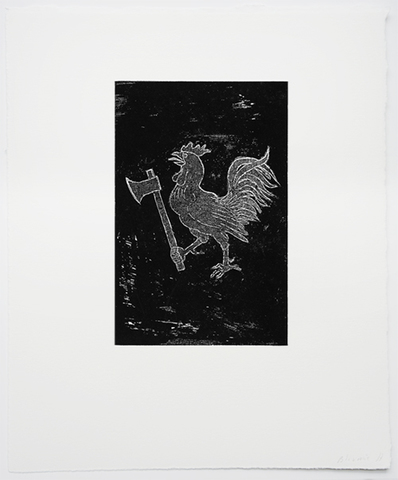
Alina Bliumis
Amateur Bird Watching at Passport Control, Rooster, Kenya, 2020
Archival paper, digital printing with pigment ink
50 х 41 см
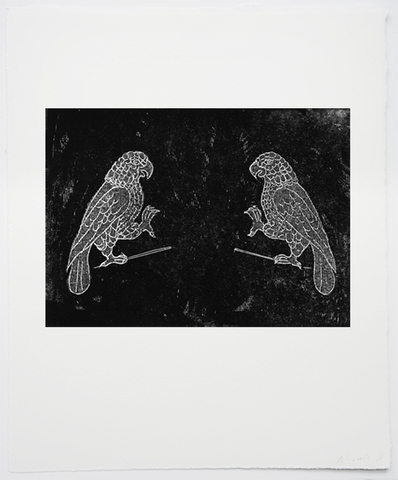
Alina Bliumis
Amateur Bird Watching at Passport Control, Sisserou Parrots, Dominica, 2020
Archival paper, digital printing with pigment ink
50 х 41 см
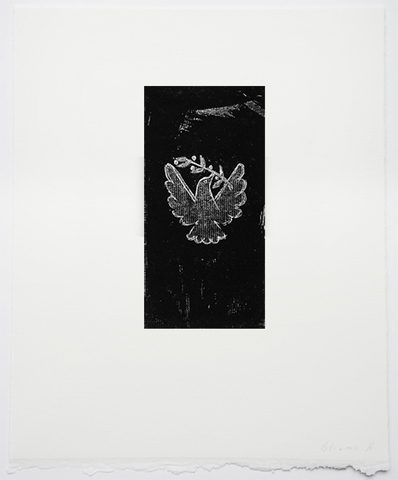
Alina Bliumis
Amateur Bird Watching at Passport Control, Dove, Cyprus, 2020
Archival paper, digital printing with pigment ink
50 х 41 см
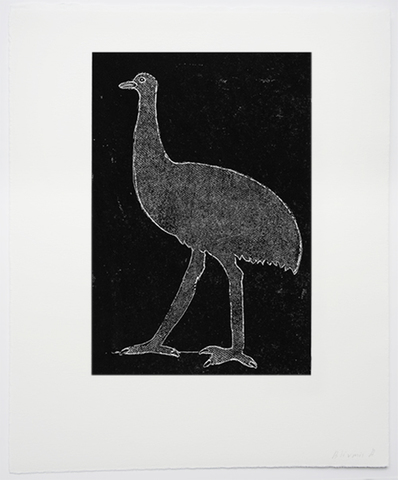
Alina Bliumis
Amateur Bird Watching at Passport Control, Emu, Australia, 2020
Archival paper, digital printing with pigment ink
50 х 41 см

Alina Bliumis
Amateur Bird Watching at Passport Control, Harpy, Liechtenstein, 2020
Archival paper, digital printing with pigment ink
50 х 41 см

Alina Bliumis
Amateur Bird Watching at Passport Control, Dodo, Mauritius, 2020
Archival paper, digital printing with pigment ink
50 х 41 см
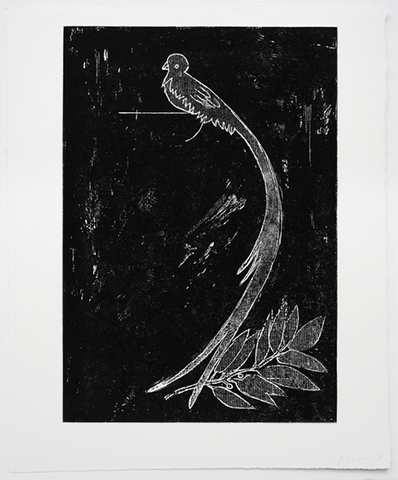
Alina Bliumis
Amateur Bird Watching at Passport Control, Quetzal, Guatemala, 2020
Archival paper, digital printing with pigment ink
50 х 41 см
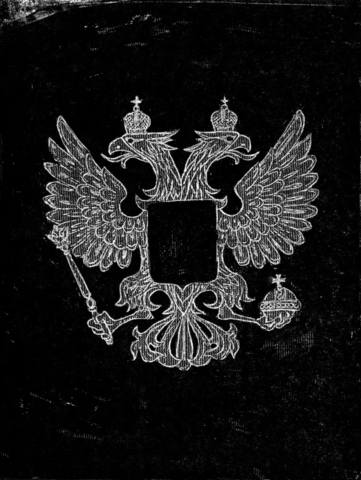
Alina Bliumis
Amateur Bird Watching at Passport Control, Imperial Eagle, Russia, 2020
Archival paper, digital printing with pigment ink
50 х 41 см
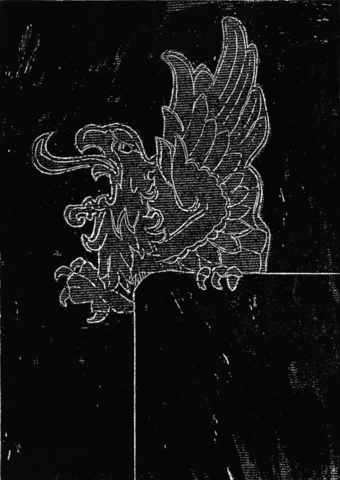
Alina Bliumis
Amateur Bird Watching at Passport Control, Griffin, Iceland, 2020
Archival paper, digital printing with pigment ink
50 х 41 см
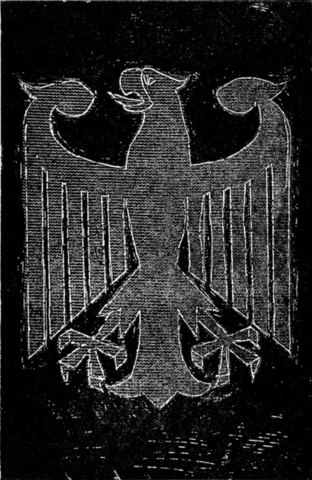
Alina Bliumis
Amateur Bird Watching at Passport Control, Eagle, Germany, 2020
Archival paper, digital printing with pigment ink
50 х 41 см
